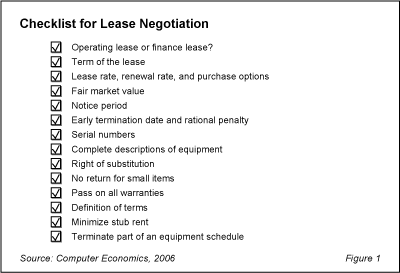When it comes to leasing IT equipment, flexibility is a good thing. Business conditions fluctuate, capacity needs change, and new technologies are constantly being introduced. No company likes to be locked into a lease that does not offer the ability to terminate early with or without an early termination penalty.
This Research Byte is a summary of our full report, How to Negotiate a Computer Lease for Maximum Flexibility.
Many end-user organizations (lessees) enter into master lease agreements assuming that the leasing company (lessor) will work with them if they need to return the equipment during the course of the initial lease term. A lessee may have built a solid relationship with its leasing company representative over a period of years, but hoping that the lessor will be flexible based on that relationship alone is not a good idea when the time comes for early termination of an equipment lease.
This is not to say that leasing companies will not try to provide as much flexibility as they can, but the bottom line is that the lessor must maintain profit levels to stay in business–especially in today’s economy. That overriding business imperative can often negate the flexibility the lessor may have provided in the past, despite the “good-ol’-boy” relationship they may have enjoyed. Obviously, the lessor can afford to be a lot more flexible if the next equipment lease is part of the termination negotiations. The lessor might even look the other way if there are a few minor missing items, or he may accommodate a rental extension at a good rate if the lessee needs to keep some of the leased equipment beyond the original terms of the lease.
However, the lessee pays for all of this flexibility, which typically translates into a higher leasing rate. While a lessee might consider the flexibility worth the higher rate, in the long run this arrangement can be problematic. What happens if the lessee’s marketing representative leaves or the leasing company is sold or files for bankruptcy? The lessee may not continue to receive the same flexibility it thought it had when it negotiated the lease.
Therefore, to ensure flexibility in the terms of the lease agreement, be sure those terms are clearly spelled out before you sign on the dotted line. The full version of this article enumerates fourteen leasing terms and conditions that lessees should clarify up front to best serve the buyer’s interest and grant maximum flexibility throughout the term of the lease.
This report assumes that the lessee has already selected a supplier/vendor/manufacturer for the equipment and that they have agreed to the configurations. Figure 1 provides a checklist of typical terms and conditions to negotiate before entering into a lease agreement. While the lessee may not be capable of negotiating every point, it is important to achieve a proper balance based on the lessee’s specific priorities and needs. We address each of these items in the full version of this article.

The full version of this report defines and discusses each of these fourteen points in detail. Comparative and evaluative data is provided on each topic to assist lessees in their lease negotiations.
Leasing agreements are often lengthy documents, printed in small type, and loaded with legal jargon, designed to give the impression that they cannot be easily understood or modified. Therefore, too many buyers simply accept the lease agreement as is, or delegate the review to the legal department, which may only look at the document from a legal perspective.
This is a mistake. The fourteen terms and conditions outlined in the full version of this article are all negotiable points. When considered one at a time, they are not difficult to understand. If a lessee can do a reasonably solid job negotiating these terms and conditions, it will minimize the business risk to the organization and it will gain significant flexibility in managing its leasing relationships.
November 2006
This Research Byte is a brief overview of our report on this subject, How to Negotiate a Computer Lease for Maximum Flexibility. The full report is available at no charge for Computer Economics clients, or it may be purchased by non-clients directly from our website at https://avasant.com/report/how-to-negotiate-a-computer-lease-for-maximum-flexibility-2006/ (click for pricing).

